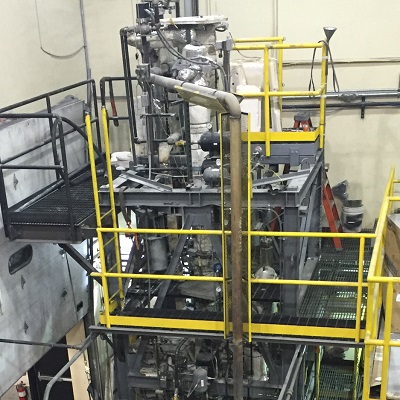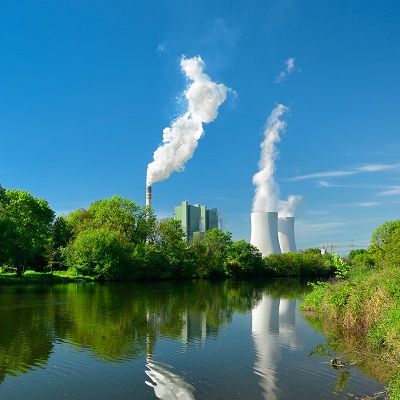Meet Dr Peter Clough, Lecturer in Energy Engineering within Cranfield’s Centre for Climate and Environmental Protection...

Dr Clough’s research is looking at hydrogen and decarbonisation technologies, with the aim of producing hydrogen cleanly for large-scale use in industry.
We interviewed him to find out more about his research and to discover more about how hydrogen can be used as an energy carrier.
Can you tell us a little about your role within the Centre for Climate and Environmental Protection, and what your research covers?
“I’m one of the leads looking after HyPER, which is, I think, the biggest project in the University at the moment. I'm an energy engineer and one of the University’s experts in hydrogen. I look at how we can produce hydrogen cleanly, I look at capturing CO2 emissions from industry, and I look at ways in which you can scale up technologies and high temperature, thermo-chemical processes. The process of producing hydrogen produces about 10 kg of CO2 per kilogramme of hydrogen, which is terrible in terms of climate change; it makes hydrogen production around the world equivalent to all of aviation and shipping. So, we want to stop that CO2 going into the atmosphere. At HyPER, we are making hydrogen, but capturing those CO2 emissions at the same time. With traditional methods, you use a carbon capture storage system to capture the CO2. It’s an easy way of doing it but it’s not very efficient or cost-effective. HyPER is looking at capturing the CO2 within the chemical reactions itself, to achieve lower cost and carbon footprint.”
Tell me more about hydrogen – what is it used for at the moment, and what are the possibilities?
“At the moment, hydrogen is mostly used to make ammonia – which then goes into fertiliser – and in oil and gas refining. It has a few other niche uses, such as in the glass industry, where they use hydrogen because it burns hotter and you get a nice, clean flame, and in a few other small things like semiconductors and food."
In the future, that could all change because, in terms of the technology, hydrogen could be used for everything. But what it will be used for will largely depend on Government policy at the time, because it makes more sense to put hydrogen into certain things than others. If you look at something like domestic heating, you could replace all of the natural gas boilers in the UK with hydrogen boilers and switch over the entire country to hydrogen heating quite easily. Hydrogen boilers already exist, and it’s a relatively easy transition to make, the same as it would be to replace like for like. I think we might end up going down that route, because the alternatives to hydrogen boilers are heat pumps. They are essentially like a small air conditioning unit on the side of a house and they connect into your existing system, take electricity and turn that into heat. It’s a really efficient way of doing it, but it doesn’t work the same way. Your radiators don’t get as hot. You have to leave the heating on for longer, and you have to have a really insulated house. I don’t think people in the UK will go for that, whereas if we can just swap the gas in the fuel, it may be more expensive but it’s a nice, simple transition."
You could also use hydrogen in vehicles, particularly in bigger vehicles like trains, buses and HGVs, where it makes a lot of sense because there aren’t really other options.”
There are different colours of hydrogen, aren’t there? What do they mean?
“The colours are derived from the different ways of producing hydrogen and are mainly based on how much CO2 is released during the process. Our hydrogen would be blue hydrogen, because we capture the CO2."
On the other hand, the purity of the hydrogen essentially means what you can use it for at the end. If you are looking to burn the hydrogen in a boiler inside a home, you don't need super high purity, you just need good enough, nice clean fuel. If you're putting that fuel into a fuel cell for a car or a lorry then you need much higher purity, mostly because fuel cell manufacturers are still making fuel cells that degrade with impurities in the gas stream, so you need to have a high purity of hydrogen.”
What drew you to energy engineering as a career path?
“When I was younger, I was naïve. As an undergraduate, and even before that, I heard all these things about the climate crisis and energy crisis and I thought: ‘I can solve that issue. I can solve the climate crisis by just doing cool, fancy things’. So, that's how I got interested in energy, and I didn't really stray away from that dream. I always maintained that I was going to be a person developing technologies for the energy crisis and trying to solve climate change. As I got more through my career, I realised it's not a one-person job – you can't solve climate crisis on your own. I might be able to play a part in it, but I'm not going to solve it myself. During my PhD, I was focusing on making hydrogen using the same process as HyPER but on a very small scale. It's now being scaled up, which is great to see, and we're working with other industry partners that are also looking into hydrogen as well, and supporting that.”
What does a typical day look like for you?
“A typical day for me is receiving about 120 emails and then probably sending another 120 or more as well. There is teaching and student supervision, but mine is a project management role mostly.”
Why did you choose to work at Cranfield?
“When I was applying for jobs, I applied for quite a few places and I had a few different job offers. I chose Cranfield because of its industry representation. I knew at the time that Cranfield had a reputation for working with industry, and I knew that I had the idea of solving climate change. I thought: ‘I'm not going to solve climate change on my own, sitting at a desk, doing some fancy research on very small things. You've got to get these technologies scaled up.’ We don’t need new technologies to solve climate change; we just need to build the stuff and scale it up quickly. I thought Cranfield was probably the best place for doing that. It has the space. It's got the industry connections.”
What is your favourite part of your job?
“Every Tuesday I spent two hours talking to my PhD students, my postdocs. They are the people that are actually doing the research. They're the ones on the ground, in their labs, doing the stuff. Learning what they're doing and being able to help them is fantastic – I love it. I then spend the rest of the day talking to the Master’s students. At the moment, they're doing their thesis projects so they're in the labs, doing the research. They're doing the ones the cool stuff. Talking to them and finding out about what they're doing is what I really enjoy.”
Tell me more about the HyPER project.
“The project is funded by the Department for Business, Energy and Industrial Strategy and it is in collaboration with Doosan Babcock and the Gas Technology Institute based in Chicago and Los Angeles in the US. The project is aiming to take a technology that has been successful at a small lab scale, so something that we would do at Cranfield anyway, and we're scaling up to the next size up, which is about 24 times larger than what currently exists and will actually be the biggest in the world at the time. Then, in the future, we’re going to be looking to scale up again to the next scale, which will be a fully commercially operating plant. In the project, we’re aiming to produce about 40 kg of hydrogen per hour, which is quite a lot. We will be producing quite a lot of CO2 as well, but we show that we can capture that CO2 at the same time. So, we want to demonstrate the technology running for a long period of time at a bigger scale, with all the issues about solids handling and solids mass transfer, demonstrating all of the key components in operation together. That'll be the first time it's been done.”
Why does this project matter? What does it aim to do?
“The UK Government has an ambition for five gigawatt of low carbon hydrogen production capacity by 2030. To scale up hydrogen production, you want to do it as cheaply as possible, but you also need to consider that we have this net zero target. Any plant you build now is going to be in operation by 2050, so it's got to produce very clean hydrogen. So, you want be able to capture as much CO2 as possible from any process you do. You want to do it as big as you possibly can, as cheaply as you can. Our technology is one of the ways in which you can do that.”
What could be the real-world impact?
“At the moment, hydrogen is made for a particular use, but I think we're very quickly moving towards a world where hydrogen will just be made, and there'll be multiple users and multiple outlets for it. Hopefully, HyPER will be one of the projects that leads on that. There's a lot of hydrogen research going on in the University, from production, to supply, to storage and transportation uses, and even hydrogen combustion gas turbines.”
Is the project interdisciplinary? If so, how does it bring together the different fields/themes?
“Yes, with HyPER, we’re going from nothing to designing, engineering, procuring, building and operating a pilot plant that’s essentially a big chemical reactor. In order to do that, we’ve got electrical engineers, chemical engineers, mechanical engineers, civil engineers – a huge range of engineers. Then, in the background, there are people in business development and marketing, taking what we've got now, showing it to others and asking if they would like to be involved in the next stage, which is developing and building a commercial plant.”
Do you have any advice to offer potential students who are thinking of coming to Cranfield to study energy engineering?
“My advice to new students or to potential students is to maintain your naivety. Maintain your ambition to do crazy things. Plan those new ideas, that when you think about it, you think: ‘This might just work’. Maintain that ambition, because it's that motivation that's going to get you through. You won't be the person that does everything, because no one person does, but you'll probably be a part of it because you've got the motivation to do it.”
And finally, what do you do when you’re not working?
“Gardening. Spending time my son. I've got another baby on the way in December, so I'm wondering how I’m going to cope with a three-year-old and a zero-year-old, because it's hard enough at the moment. How am I going to cope another child?! That, I have not kept my naivety for! That, I'm quite concerned about! I think building a new pilot plant is probably easier than looking after two young children!”
Supporting information on Dr Peter Clough and his work on hydrogen and decarbonisation technologies
Interested in learning more about hydrogen and decarbonisation technologies? Alumni can read recent articles, available through databases in the Alumni Library Online service, on low-carbon hydrogen and carbon capture.
For published papers by Dr Peter Clough, go to Cranfield University’s research repository CERES and search for Peter Clough.
ABI-Inform
The Role of Green and Blue Hydrogen in the Energy Transition—A Technological and Geopolitical Perspective. (2021). Sustainability, 13(1), 298.
New Concepts of Hydrogen Production and Storage in Arctic Region. (2021). Resources, 10(1), 3.
Gökçe Mete, & Reins, L. (2020). Governing New Technologies in the Energy Transition – The Hydrogen Strategy to the Rescue? Carbon & Climate Law Review : CCLR, 14(3), 210-231.
Akimoto, Y., Minei, Y., & Okajima, K. (2021). Evaluation of Impurity Concentration Process and Mitigation Operation in Fuel Cell System for Using Biogas. Reactions, 2(2), 115.
Ceran, B. (2020). Multi-Criteria Comparative Analysis of Clean Hydrogen Production Scenarios. Energies, 13(16), 4180.
EBSCO Business Source Alumni
Kafafi, A. (2020). Carbon capture and storage: A feasible way to achieve climate goals: New technology can help reduce greenhouse emissions from manufacturing. ISE: Industrial & Systems Engineering at Work, 52(2), 46–51.
Webster, E. (2020). Transnational legal processes, the EU and RED II: Strengthening the global governance of bioenergy. Review of European Comparative & International Environmental Law, 29(1), 86–94.
Emerald Journals
Mishra, S. and Singh, S.P. (2021). Carbon management framework for sustainable manufacturing using life cycle assessment, IoT and carbon sequestration. Benchmarking: An International Journal, 28(5), 1396-1409.
IEEE ASPP Journals
- He, D. S. Mallapragada, A. Bose, C. F. Heuberger and E. Gençer. (2021). Hydrogen Supply Chain Planning With Flexible Transmission and Storage Scheduling. IEEE Transactions on Sustainable Energy, (12)3, 1730-1740.
Open access articles in ScienceDirect from Elsevier
Although Elsevier do not generally permit alumni access to ScienceDirect material, don’t forget there are many articles available via open access (the author has paid to allow their article to be publicly available without subscription). Here are a few examples of articles on low-carbon hydrogen:
Simona Liguori, Kourosh Kian, Nora Buggy, Bryce H. Anzelmo, Jennifer Wilcox. (2021). Opportunities and challenges of low-carbon hydrogen via metallic membranes. Progress in Energy and Combustion Science, (80), 100851.
Full text: https://doi.org/10.1016/j.pecs.2020.100851
Stefano Consonni, Luca Mastropasqua, Maurizio Spinelli, Timothy A. Barckholtz, Stefano Campanari. (2021). Low-carbon hydrogen via integration of steam methane reforming with molten carbonate fuel cells at low fuel utilization. Advances in Applied Energy, (2), 100010.
Full text: https://doi.org/10.1016/j.adapen.2021.100010
Hai-Wen Li, Nobuyuki Nishimiya. (2021). Insight from Japan’s Hydrogen Strategy and Activities. Engineering. Available early online 19 March 2021.
Full text: https://doi.org/10.1016/j.eng.2020.12.020
Marcus Newborough, Graham Cooley. (2020). Developments in the global hydrogen market: The spectrum of hydrogen colours. Fuel Cells Bulletin, (2020)11, 16-22.
Full text: https://doi.org/10.1016/S1464-2859(20)30546-0
Kari Espegren, Sigrid Damman, Paolo Pisciella, Ingeborg Graabak, Asgeir Tomasgard. (2021). The role of hydrogen in the transition from a petroleum economy to a low-carbon society. International Journal of Hydrogen Energy, 46(45), 23125-23138.
Full text: https://doi.org/10.1016/j.ijhydene.2021.04.143
New to the ALO? Follow these simple steps to access your Alumni Library Online service:
- Go to your alumni portal
- Log in with your details
- Scroll down the page and click on Alumni Library Online
- Click on Databases to find the databases listed above.
Forgotten your portal login?
Please email the Alumni team.
Any other questions?
Contact your ALO team.


